牛津8A Unit 3 Main task
- 格式:ppt
- 大小:2.52 MB
- 文档页数:24
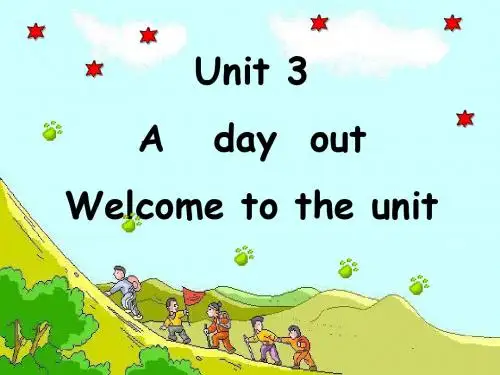
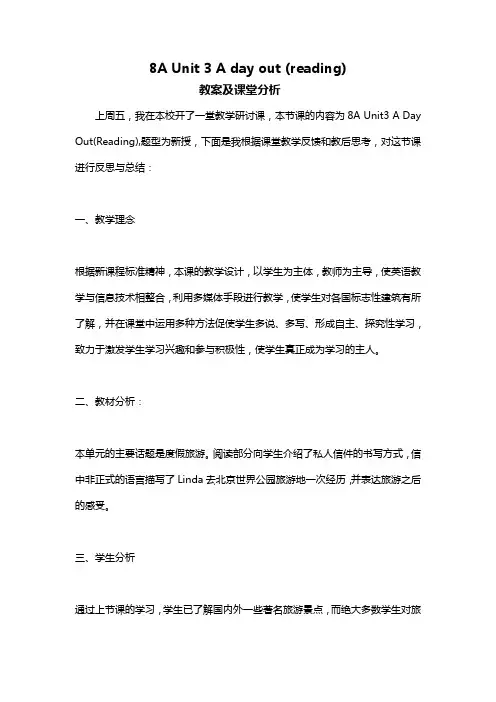
8A Unit 3 A day out (reading)教案及课堂分析上周五,我在本校开了一堂教学研讨课,本节课的内容为8A Unit3 A Day Out(Reading),题型为新授,下面是我根据课堂教学反馈和教后思考,对这节课进行反思与总结:一、教学理念根据新课程标准精神,本课的教学设计,以学生为主体,教师为主导,使英语教学与信息技术相整合,利用多媒体手段进行教学,使学生对各国标志性建筑有所了解,并在课堂中运用多种方法促使学生多说、多写、形成自主、探究性学习,致力于激发学生学习兴趣和参与积极性,使学生真正成为学习的主人。
二、教材分析:本单元的主要话题是度假旅游。
阅读部分向学生介绍了私人信件的书写方式,信中非正式的语言描写了Linda去北京世界公园旅游地一次经历,并表达旅游之后的感受。
三、学生分析通过上节课的学习,学生已了解国内外一些著名旅游景点,而绝大多数学生对旅游这个话题都情有独钟,讲不尽的话题、说不尽的言语,学生仍是意犹未尽、兴致盎然。
适时引导进入本节课的内容,在一日旅游玩世界听起来几乎是不可能的事情,Linda却能做到。
从而极大调动学生积极性和提升他们的兴趣,利于课内各项任务活动的开展。
四、教学设计过程:此次公开课乃是借班上课,可以这样说完全是在一个陌生情况下上课,故真实性较强,值得自己及广大同仁课后思考和借鉴。
和其余班相比,该班学生课堂较为冷清,学生参与课堂的积极性不高,故而我在制作课件时,有意将多媒体课件做得卡通一些,以吸引他们的眼球。
课前热身我三句话不离本行,多提问一些与旅游相关问题,逐渐过渡到本节课的内容,做到过渡自然。
当然,为了扫除学生之后阅读障碍,很有必要先教会词汇。
以下则为阅读的基本模式:快速阅读、细节阅读等,我在学生精读课文的同时,使用不同题型帮助学生更好更快了解课文,如判读正误、图表等。
在阅读后我做的是一小升华部分,学生通过本节课大部分的学习,得学会介绍自己的旅游出行计划。
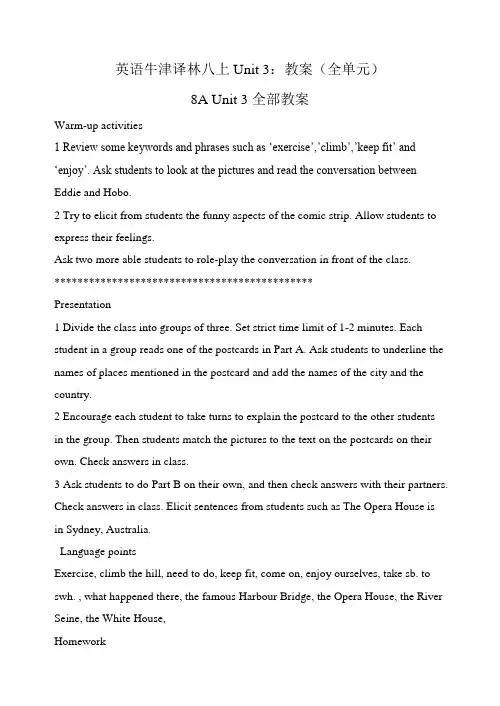
英语牛津译林八上Unit 3:教案(全单元)8A Unit 3全部教案Warm-up activities1 Review some keywords and phrases such as ‘exercise’,’climb’,’keep fit’ and‘enjoy’. Ask students to look at the pictures and read the conversation between Eddie and Hobo.2 Try to elicit from students the funny aspects of the comic strip. Allow students to express their feelings.Ask two more able students to role-play the conversation in front of the class.*********************************************Presentation1 Divide the class into groups of three. Set strict time limit of 1-2 minutes. Each student in a group reads one of the postcards in Part A. Ask students to underline the names of places mentioned in the postcard and add the names of the city and the country.2 Encourage each student to take turns to explain the postcard to the other studentsin the group. Then students match the pictures to the text on the postcards on their own. Check answers in class.3 Ask students to do Part B on their own, and then check answers with their partners. Check answers in class. Elicit sentences from students such as The Opera House isin Sydney, Australia.Language pointsExercise, climb the hill, need to do, keep fit, come on, enjoy ourselves, take sb. to swh. , what happened there, the famous Harbour Bridge, the Opera House, the River Seine, the White House,Homework1 Learn the language points by heart.2 一课三练P.253 Preview the Reading Part.****************************************************Revision1 Review key vocabulary according to the general ability of the class. Presentation (Reading A)1 Show the pictures of the World Park in Beijing. Elicit the names of the places or building.2 Explain to students the context of the letter. Ask Who’s writing the letter? Who’s Linda? Who’s she writing to?3 Read the letter to the class while students follow in their books. Try to read with expression.4 Divide the class into groups of three and allocate one part to each group. Ask them to find adj., verbs or phrases in the letter, which describe how Linda felt that day. They can either underline the words they do not know or write them on a piece of paper. Then go through the words students have underlined.5 Ask students in each group to go through the three sections in Linda’s letter and discuss the different feelings expressed in it.3 Ask students to write a schedule of the day out indicating places and movements only. Ask them to list the key words.6 Check students’ understanding. Ask comprehension questions.**********************************************Presentation (Reading B)1 Ask students to read the conversation on their own.2 Ask students to replace the underlined phrase with the correct words. Encourage less able students to find the words in the letter on page 36&37.3 Ask students to compare answers in pairs. Then ask two students to read out the conversation in class to check the correct answers.4 Ask students to write the list of new words and definitions in their vocabulary record books.5 Divide the class into pairs and ask them to read the conversation.**********************************************Presentation (Reading C)1 Do Part C as a class competition.2 Ask students to close their books . Then read the sentences at random one at a time. Write them on the Bb only one at a time. Make it clear that students raise their hands when they are ready to answer.3 Ask students to correct the false sentences. Allow less able students to open their books and find the correct information.4 Talk to students about a home page to focus their attention on Part C2. Then ask them to sequence the pictures on Daniel’s home page on their own.5 Check answers as a whole class activity.6 Ask students if there are any disagreements. Encourage them to explain why they have selected a certain sequence in order to identify reasons for mistakes. Language points (Part A)Invite sb. to do, at the beginning, get on a coach, be boring, on the highway, feel sick, most of the trip, arrive at, be made of metal, in front of, places of interest, from all over the world, the real ones in Egypt, an amazing day, join in, teach himself, a home page, for everyone to look atLanguage points (Part B)Travel from one place to another, movement of cars, the main road, come up from your stomach, the tall metal building, the old stone buildingLanguage points (Part C)It takes sb. time to doHomework1 Learn the language points by heart.2 一课三练P.26-273 Preview the Vocabulary Part.****************************************************** Presentation (Vocabulary)1 Part A is a recognition task asking students to identify the English names of popular places of interest in Beijing. Bring in photos of these places.2 Explain the context of the tasks. Ask students to study the pictures and words.2 Ask students to check answers with a partner. Then check the correct answers with the whole class by asking individual students to read out the sentences.3 Part B is a problem-solving task and students need to use their existing knowledge of Beijing to do it. Bring in a map of Beijing.4 Revise means of transport by asking students how they go to school or work.5 Ask students to do the task in pairs. Then ask students in a pair to compare their answers with another pair. Then ask students to take turns to read the sentences aloud to check the correct answers.Language pointsThe Monument to the People’s heroes, the red maple leaves, walk slowly around the big lake, feel the beauty of…, the names of the transport, more than an hour. Homework1 Learn the language points by heart.2 一课三练P.283 Preview the Grammar Part.************************************************Presentation (Grammar Part A)1 Elicit from students the context illustrated in the picture.Focus students’ attention on the trip and how the Class 1, Grade 8 students felt at the time. E.g., How was the trip? (boring, too long) Then ask them to form sentences with the keywords and write them on the Bb. E.g., The trip was boring. It was too long. Ask them to join the two ideas in one sentence.2 Ask students to list other similar ideas about the journey using ‘and’.3 Ask students to combine the two contrasting ideas--- of a boring trip on the coach and a wonderful day. Ask them when we use ‘and’ and ‘but’ to elicit the rulers.4 Ask students to combine the two options.5 Elicit a few sentences from students’ own experiences, focus on the sentences with the same subjects and verbs.6 This is a deductive learning activity. Encourage students to work it out as a problem-solving task following a set sequence of deduction. Students should be able to work out the correct joining word and also which words to delete by applying rules on Page 41.7 Elicit feedback from the class. Ask students to read out their new sentences. The others listen carefully and express agreeme nt or disagreement. If there’s any disagreement, encourage students to explain their reasons to help them focus on the different details of the rule.********************************************Presentation (Grammar Part B)1 Read the sample sentences. As k students to identify the verb and the ‘to’-infinitive in each sentences.2 Elicit other verbs that are usually used with ‘to’-infinitive. Give them the extra examples listed on page 43.3 Ask students to complete ‘Work out the rule!’ at the bottom of the page. For less able students, tell them to go through the example sentences and the explanations again.4 Ask students to complete the conversation in pairs. They should make sense of the sentences before they select a verb. Remind less able students that they need to use ‘to’-infinitives in the conversation.6 Ask students to read the conversation in pairs. Ask a pair of more able students to read out the conversation to the class.**************************************************Presentation (Grammar Part C)1 Write down some sentences containing reflexive pronouns. You can use the following examples:* I fell over and hurt myself.* My baby sister can feed herself.* My cat cleans itself every day.* We found ourselves in the centre of the city.2 Underline the reflexive pronouns in the sentences. Explain the use of reflexive pronouns. Tell them we use them when the subject and the object are the same person or thing.3 Explain the difference between reflexive and personal pronouns by giving some examples.4 Go through the table. Make sure students are able to distinguish between the singular and plural forms.5 Write some more verbs, e.g., ‘teach’, ‘give’, ‘buy…for’,’ look after’,etc.6 Ask students to complete ‘Work out the rule!’ at the bottom of the page.7 Explain the context and tell students that they need to find out Linda and Simon’s secret. Ask students to read the cartoon story first without working out the correct reflexive pronouns. Check the understanding of the vocabulary.8 Then ask students to go through the story again and work out the correct reflexive pronoun for each blank.9 Ask more able students to read out the speech bubbles in sequence. The rest of the class should listen carefully and check their answers.Language pointsDecide to do, prepare to do, see the sunset, take some photos of it,climb the rocks, hide-and-seek, pull himself up, luckily, do not tell anybody about this, keep their secret to themselvesHomework1 Learn the language points by heart.2 一课三练P.29-303 Preview the Integrated skills Part.************************************************Presentation (Integrated skills A)1 Talk to students about different school events. Elicit from students names of such events, e.g., a sports day, a funny day, a school fair, etc.2 Set the context of organizing sports, music, drama or any other events involving competition.3 Briefly review language required for a schedule using your students’ own experience. Use information based on the school. Write some details on the Bb.4 Read the poster in pairs. Ask some questions to find out the main points, e.g. , What’s it about? Who is it about? What will happen? Where will it happen? When?4 Ask students to look at Kitty’s notes and complete as much of the schedule as possible on their own. Encourage them to find the answers in the poster and underline them.5 Play the recording for Part A2 and ask students to complete the rest of the notes on their own.Play the recording again so that Ss are able to check, confirm or change their initial responses.6 Ask more able student to read the completed notes to the whole class to check answers .7 Present Part 3 as a quiz reading the sentences one by one. Ask more able student to rewrite the false statements with the correct details.Presentation (Integrated skills B)1 Ask students to practice the conversation in pairs and then change roles.2 Close the books and listen to me while I read the conversation. Ask students to repeat the sentences as they hear them.3 Encourage Ss to memorize the sentences. Ask them to pretend they are talking on the phone.4 Ask Ss to work in pairs and use the conversation as a model to make suggestions about visiting a place, express their opinions and make arrangements.Language pointsTh e final of…, take place, cheer for our team, with your support, we will win,half-time, presentation of cup and medals, per person, cost of the trip, over an hour, Shall we go to the Great Wall?, I’m afraid…, Why don’t we…?, play hide-and-seekHomework1 Learn the language points by heart.2 一课三练P.313 Preview the Study skills, Main task & Checkout Part.****************************************************** Presentation (Study skills)1 Make Ss aware of the difference between facts and opinions. Ask more able students what is a fact and what is opinion.2 Ask students to read the leaflet about the World Park.3 When they are comparing their answers, ask them to underline the words which express opinions and personal feelings.Language points (Study skills)467,000 square metres in areaPresentation (Main task)1 Introduce the topic of planning a day out. Ask Ss to bring in brochures of local places which they would like to visit.2 Elicit from Ss the need for accuracy in terms of times, dates, transport, places and types of activities.3 Remind students the context of this section. Go through the plan in Part A and point out the information which Kitty and Daniel want to include in the invitation letter.4 Tell Ss that the model plan prepares them for writing an invitation letter with their own information and details.5 Ask students to go through kitty and Daniel’s letter quickly and complete it on their own.6 Direct Ss’ attention to the different parts of the letter. Ask students to cover the prompts on the left. Ask them to match them with the corresponding parts in kitty and Daniel’s letter.7 Ask students to write a rough draft using the plans they have prepared in Part B. Language points (Main task)Is coming to visit you, all the way to…,************************************************Presentation (Checkout)1 Revise the use of joining words, reflexive pronouns and verbs +to infinitives.2 Ask students to read through the conversation and complete the sentences.3 Check the correct answers with the whole class and tell them to write their scores in the paw.4 Ask Ss to look at the pictures in Part B and explain the context. Ss then write the names of the places on their own.Language points (Checkout)Planned to go, pack my bag instead, play badly, shuttle bus, go climbing on rocks Homework1 Learn the language points by heart.2 一课三练P.32-343 Preview the Unit 4.。
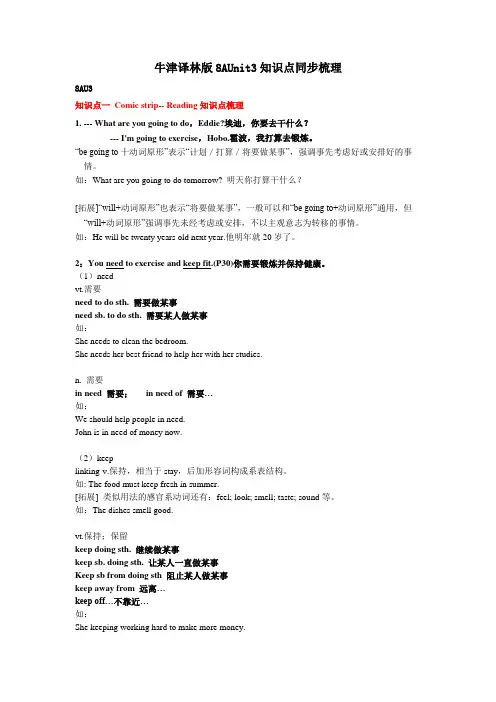
牛津译林版8AUnit3知识点同步梳理8AU3知识点一Comic strip-- Reading知识点梳理1. --- What are you going to do,Eddie?埃迪,你要去干什么?--- I'm going to exercise,Hobo.霍波,我打算去锻炼。
“be going to十动词原形”表示“计划/打算/将要做某事”,强调事先考虑好或安排好的事情。
如:What are you going to do tomorrow? 明天你打算干什么?[拓展]“will+动词原形”也表示“将要做某事”,一般可以和“be going to+动词原形”通用,但“will+动词原形”强调事先未经考虑或安排,不以主观意志为转移的事情。
如:He will be twenty years old next year.他明年就20岁了。
2:You need to exercise and keep fit.(P30)你需要锻炼并保持健康。
(1)needvt.需要need to do sth. 需要做某事need sb. to do sth. 需要某人做某事如:She needs to clean the bedroom.She needs her best friend to help her with her studies.n. 需要in need 需要;in need of 需要…如:We should help people in need.John is in need of money now.(2)keeplinking-v.保持,相当于stay,后加形容词构成系表结构。
如: The food must keep fresh in summer.[拓展] 类似用法的感官系动词还有:feel; look; smell; taste; sound等。
如:The dishes smell good.vt.保持;保留keep doing sth. 继续做某事keep sb. doing sth. 让某人一直做某事Keep sb from doing sth 阻止某人做某事keep away from 远离…keep off…不靠近…如:She keeping working hard to make more money.I’m sorry to keep you waiting for me.We should keep away from danger all the time.Please keep off the grass in the park.(3)fitadj.健康的;合适的be fit for适合…be fit for sb. to do sth.适合某人做某事如:Keeping fit is always important.She is fit for the position.vt.fit sb 适合某人The coat fits you well.3:Come on,Hobo. Let's enjoy ourselves! (P30)快点,霍波。
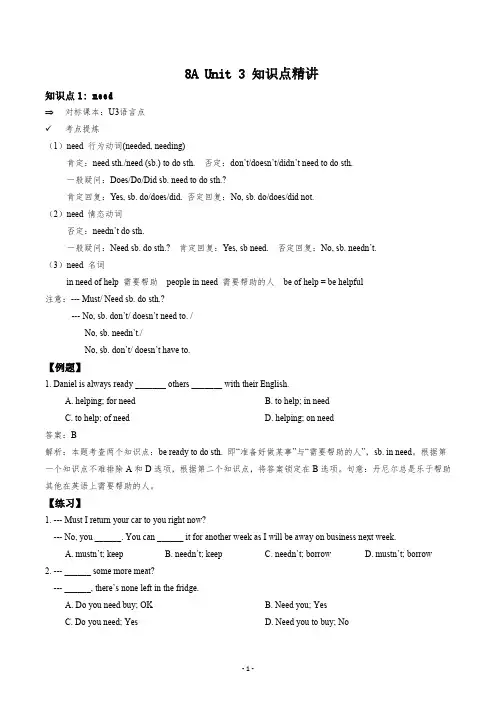
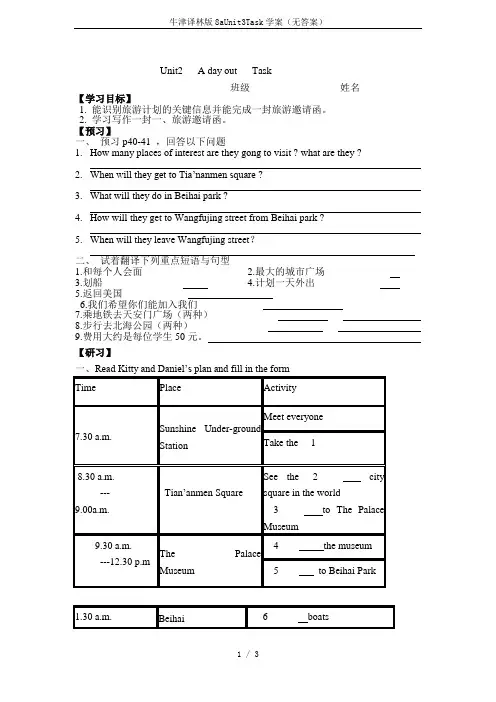
Unit2 A day out Task班级____________ 姓名___________【学习目标】1. 能识别旅游计划的关键信息并能完成一封旅游邀请函。
2. 学习写作一封一、旅游邀请函。
【预习】一、预习p40-41 ,回答以下问题1.How many places of interest are they gong to visit ? what are they ?2.When will they get to Tia’nanmen square ?3.What will they do in Beihai park ?4.How will they get to Wangfujing street from Beihai park ?5.When will they leave Wangfujing street?二、试着翻译下列重点短语与句型1.和每个人会面__________________2.最大的城市广场_____________3.划船____________4.计划一天外出_____________5.返回美国_____________6.我们希望你们能加入我们_____________7.乘地铁去天安门广场(两种)_____________8.步行去北海公园(两种)_____________9.费用大约是每位学生50元。
【研习】一、Read Kitty and Daniel’s plan and fill in the form二、Linda will go back to the USA soon. 琳达不久将返回美国。
go back to …=return to…返回另:return=give back归还When will you _____ _____ the USA? = When will you _____ _____ ____ the USA?【练习】一、用括号中所给单词的适当形式填空1. His grandma is _________ (bad) ill,and she must be sent to hospital at once.2. These boys are_________ (win) at the end of the match..3. Jack fell from the tree, but l________, He did not hurt himself.4. --- When Linda (go) back to London? --- In three days.5. If people know (much) about the problem, maybe they will do something.二、选择填空( )1.His parents were worried that he _____ too much time chatting online.A. spentB. costC. paidD. had( )2.We all felt excited when we ____ the top of the mountain because we can see the whole city clearly.A. reachedB. arrivedC. climbedD. got( )3.---I will keep it a secret _________ myself. Please don’t tell others.---OK. I will keep the secret _______ you.A.to, forB.for ,toC.for, forD. to ,to三、句型转换1. Linda will go back to the USA.(同义句改写)Linda will ________ _________the USA.2. We are planning a day out to Nanjing.(对划线部分提问)________ ________ you________?3. The trip took 2 hours. (对划线部分提问)________ ________ ________the trip________?4. He will come back in five minutes.(对划线部分提问)will he come back?四、完成句子1.我们计划乘地铁去公园。
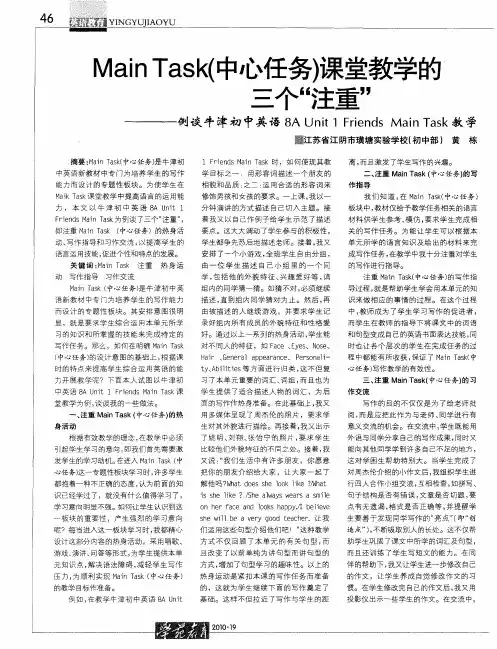
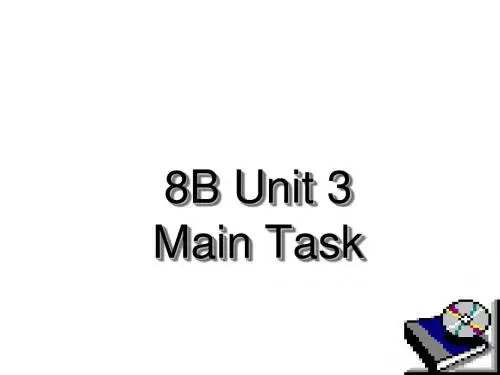
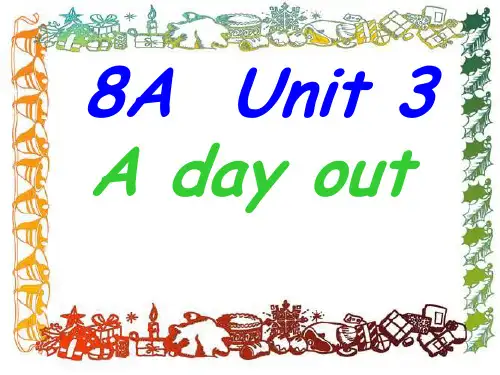


《牛津初中英语》8A教学案例设计Unit3 Reading(Ⅰ)一、教学内容:四会内容1、词汇:mom、beginning、coach、traffic、sky、model、metal、inside、whole、interest 、real 、song、Internet、main、stomach2、词组:invite…to…at the beginningget on a coacha lot of trafficfeel sickbe made of metalplaces of interest3、句型:The trip from kitty’s school took about two hours by coach.Kitty and I did not feel sick any more.The model pyramids looked just like the real ones in Egypt.When I saw them, I couldn’t believe my eyes.Kitty’s classmate Daniel taught himself how to make a home page.He put his photos on it for everyone to look at.其他内容1、词汇:highway pyramid parade movement2、词组:on the highwaynot any moreenjoy oneselfthe whole worldfrom all over the worldon the Internethome page二、分析处理与设计思路1、教材分析与处理:此部分“Around the world in a day”向学生介绍私人信件的书写方式,信中用非正式的语言描述了Linda 去北京世界公园旅游的一次经历,并表达了旅游之后的感受。
牛津初中英语8A Unit3 Reading说课教案泰兴市姚王初级中学任祥元一、说教材牛津初中英语8A共两大模块,今天我要说的是第一模块中的第三单元。
Reading部分是本单元的核心,课文内容是Linda写给妈妈的一封信。
信中她向妈妈介绍了她去北京世界公园郊游的经历。
前面学生已对世界景点有初步了解,这一课进一步让同学们欣赏这些景点并学习重要短语、句型及语法,为今后的学习打下坚实的基础。
所以在授课的过程中我将依据新课程标准,引导学生学会思考、学会学习,培养他们学习的自主性和创新意识。
二、说学情学生经过初中一年的英语学习已掌握一定的英语基础知识,具备一定的听、说、读、写的能力,通过本课的学习还要进一步提高学生运用英语的能力,提高学生的英语水平。
三、说目标1、知识目标:词组:at the beginning get on a coach feel sickplaces of interest join in句型:1. The trip from Kitty′s school took about two hours by coach.2. Kitty and I did not feel sick any more.3. The model pyramids looked just like the real ones in Egypt.2、能力目标1.训练学生听、说、读、写的能力。
2.培养学生的自学能力。
3.培养学生综合运用英语的能力。
3、情感、态度与价值观目标:激发学生对祖国、对世界的热爱之情,培养学生的审美观。
鼓励学生认真学习,立志报效祖国,为中国能傲立于世界民族之林而勤奋学习。
四、说重点与难点1.运用名词或名词词组,谈论交通工具。
eg. The trip took two hours by coach.2.运用并列连词and,but和or造句。
eg. They are small but wonderful.3.运用动词和带to 的不定式。